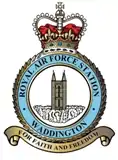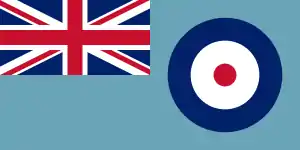No. 503 Squadron RAF
No. 503 (City of Lincoln) Squadron RAF was an auxiliary squadron of the Royal Air Force. It operated as a bomber squadron in the 1920s and 1930s, but was disbanded before the outbreak of the Second World War.
| No. 503 (City of Lincoln) Squadron RAF | |
|---|---|
| Active | 5 October 1926 – 1 November 1938 |
| Country | |
| Branch | |
| Type | Inactive |
| Role | Bomber |
| Part of | No. 6 (Auxiliary) Group RAF, Bomber Command |
| Insignia | |
| Squadron Badge heraldry | The arms of the county of Lincoln with an eagle above (unofficial)[1] |
History
The squadron was formed on 5 October 1926 at RAF Waddington in Lincolnshire as No. 503 (Bombing) Squadron of the Special Reserve,[2] manned by part-time volunteers. It was at first equipped with Fairey Fawn light day bombers. It re-equipped with the partly wooden Handley Page Hyderabad heavy night bomber in 1929, receiving the improved, all-metal Handley Page Hinaidi from 1933. Some squadron members thought the Hyderabad superior to the Hinaidi, but when a squadron member discovered dry rot in the longeron of a Hyderabad they settled for the 'newcomer', some almost having spent their life of 700 flying hours already.[3]
In October 1935, it changed role again to become a day bomber squadron, receiving Westland Wallaces. These were replaced by the Hawker Hart in June 1936, these in turn starting to be replaced by the updated Hawker Hind in July 1938. However, in 1938 it was decided to switch the role of the Auxiliary Air Force to that of air defence, and on 1 November 503 Squadron was disbanded by renumbering it to No.616 (South Yorkshire) Squadron and moving it to RAF Doncaster.[2][4]
Aircraft operated
| From | To | Aircraft | Version |
|---|---|---|---|
| October 1926 | June 1929 | Fairey Fawn | Mks.II & III |
| February 1929 | January 1934 | Handley Page Hyderabad | |
| October 1933 | November 1935 | Handley Page Hinaidi | |
| October 1935 | September 1936 | Westland Wallace | Mk.I |
| November 1935 | September 1936 | Westland Wallace | Mk.II |
| June 1936 | November 1938 | Hawker Hart | |
| June 1938 | November 1938 | Hawker Hind |
Squadron bases

| From | To | Base | Remark |
|---|---|---|---|
| October 1926 | November 1938 | RAF Waddington, Lincolnshire |
Commanding officers
| From | To | Name |
|---|---|---|
| November 1926 | S/Ldr. R.D. Oxland | |
| 15 February 1930 | W/Cdr. The Hon. L.J.E. Twistleton-Wykeham-Fiennes | |
| 15 February 1930 | 11 May 1931 | W/Cdr. H.P. Lale, DSO, DFC |
| 11 May 1931 | 9 August 1933 | W/Cdr. H.I. Hanmer, DFC |
| 9 August 1933 | January 1936 | W/Cdr. A.P.V. Daly, AFC |
| January 1936 | S/Ldr. A.F. James | |
| 30 May 1937 | S/Ldr. H. Power (acting) |
References
Notes
- Hunt 1972, pp. 267, 268, 278.
- Moyes 1976, p. 265.
- Hunt 1972, pp. 270–271.
- Jefford 2001, p. 96.
- Moyes 1976, p. 266.
- Halley 1988, p. 392.
- Hunt 1972, pp. 267–278.
Bibliography
- Halley, James J. (1988). The Squadrons of the Royal Air Force & Commonwealth, 1918–1988. Tonbridge, Kent, UK: Air-Britain (Historians) Ltd. ISBN 0-85130-164-9.
- Hunt, Leslie (1972). Twenty-One Squadrons: The History of the Royal Auxiliary Air Force, 1925–1957. London: Garnstone Press. ISBN 0-85511-110-0.
- Jackson, Robert (2006). The Encyclopedia of Military Aircraft. Parragon Books Ltd. ISBN 1-4054-2465-6.
- Jefford, C.G. (2001). RAF Squadrons, a Comprehensive record of the Movement and Equipment of all RAF Squadrons and their Antecedents since 1912 (2nd ed.). Shrewsbury, Shropshire, UK: Airlife Publishing Ltd. ISBN 1-85310-053-6.
- Lewis, Peter (1959). Squadron Histories: R.F.C, R.N.A.S and R.A.F., 1912–59. London: Putnam.
- Moyes, Philip J.R. (1976). Bomber Squadrons of the RAF and their Aircraft. London: Macdonald and Jane's (Publishers) Ltd. ISBN 0-354-01027-1.
External links
- 503 Squadron Royal Air Force
- RAF Squadron Histories 500–520 rafweb.org
